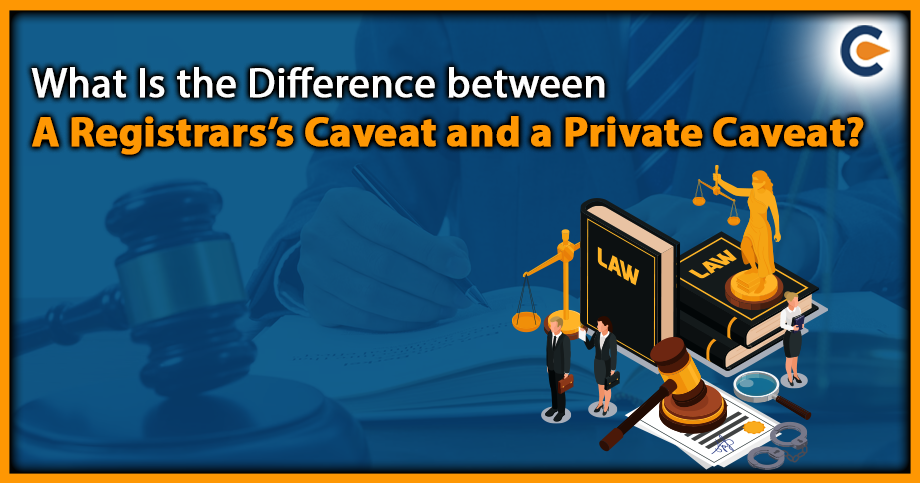Section 148A of the Code of Civil Procedure (CPC) pertains to the right to lodge a caveat. This is a notice given by a person to a court or public office to prevent certain actions from being taken without that person’s prior notice. The effect of lodging a caveat is that the court or public officer must give notice to the person lodging the caveat if any application or proceeding is instituted in respect of the matter. This gives the person lodging the caveat an opportunity to appear before the court and be heard before any orders are made. However, a caveat is a protective measure, and it is not a substitute for filing a suit or proceeding. If a person lodges a caveat, they must still file a suit or proceed within the relevant limitation period.
Meaning of Caveat
The word ‘caveat’ is not defined anywhere in the Code of Civil Procedure, 1908[1]. However, the literal meaning of the caveat is ‘let the person beware’. According to the Code of Civil Procedure, it’s a kind of precautionary measures taken by the individual who has a fear/apprehends that a case might be lodged against him in a court of law whereby by filing a caveat petition, he or she makes it aware to the court that this step if taken, should be made aware to them.
In the matter of Nirmal Chandra Dutta v. Girindra Narayan Roy & Ors. The court explained that a caveat is a caution or warning made to the court not to issue any grant or take any action without providing notice to the party lodging the caveat. It’s an action done as a safeguard against the grant of probate. It is a petition that demands that the caveator, who submits a caveat petition, have proper notice and that the applicant not be awarded any action or relief without first notifying the caveator.
Historical Development of Caveat
The concept of a caveat has existed in the legal system for centuries. In the common law system, a caveat was originally used in the context of probate matters, where it was used to prevent the grant of probate without prior notice to the caveator.
In India, the concept of a caveat was first introduced in the Civil Procedure Code (CPC) in 1908. The Code of Civil Procedure (Amendment) Act, 1976 introduced Section 148A into the CPC. The provision was introduced to provide a mechanism for protecting the interests of a person who claims a right to appear before a court in a suit or proceeding. This provision was introduced on the recommendation of the 54th Law Commission’s report by the Civil Procedure Code (Amendment) Act 104 of 1976.
The introduction of Section 148A was a significant development in the legal system, as it provided a statutory right to lodge a caveat in civil matters. This enabled parties to protect their interests and receive notice of any applications or proceedings that may affect their rights. Over the years, Section 148A has undergone several amendments. The latest amendment was made in 2002 by the Code of Civil Procedure (Amendment) Act 2002. The amendment introduced a requirement for the person lodging the caveat to provide an affidavit stating the grounds on which the caveat is based.
Section 148A of the Code of Civil Procedure, 1908
Under Section 148A of the CPC, any person claiming a right to appear before a court in a suit or proceeding is entitled to lodge a caveat. The caveat must be in writing and addressed to the court or public officer that may deal with the matter. The caveat should contain the name, description, and address of the person lodging it, as well as a statement of the rights claimed by the person. This section is mandatory in nature and contains a precautionary measure to ensure that the caveator is heard before any adverse decision is made against him.
Essentials of Section 148A
A person who asserts to have a right to appear before the court may submit a petition of caveat under clause 1 of section 148 A in the following situations:
- When there is an apprehension of application;
- Where a prior application has been submitted;
- When there is an anticipation of a lawsuit that will be filed against him;
- In a case that has already been filed.
In these situations, the caveator might lodge a caveat; thereafter, he is duty-bound to give notice of the caveat to the person against whom the caveat is lodged. And once the caveat is lodged, it is the duty of the court to give notice to the caveator whenever an application is filed against him. The duration of the caveat will be 90 days from the date of filing the caveat, and it can be extended by the order of the court. Thus, the caveat will no longer be in effect 90 days after the day it was filed unless the application mentioned in subsection (1) was submitted prior to the end of the allotted time.
Conclusion
Persons with an interest in the court’s order who anticipate that an order could be issued against them are granted the opportunity to file a caveat. A person who believes that his interests may be jeopardised if an order is made without taking them into consideration as a precautionary measure available to him in the form of a caveat. If the court receives an application within 90 days of the caveat being filed, it is required to notify the caveator of the application by serving him with a notice; otherwise, the order made by the court will be void.
Read Our Article: Who Can File A Caveat Petition?











